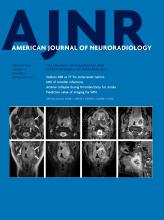Research ArticleAdult Brain
Decreased Craniocervical CSF Flow in Patients with Normal Pressure Hydrocephalus: A Pilot Study
S.M. Stöcklein, M. Brandlhuber, S.S. Lause, A. Pomschar, K. Jahn, R. Schniepp, N. Alperin and B. Ertl-Wagner
American Journal of Neuroradiology February 2022, 43 (2) 230-237; DOI: https://doi.org/10.3174/ajnr.A7385
S.M. Stöcklein
aFrom the Departments of Radiology (S.M.S., M.B.)
M. Brandlhuber
aFrom the Departments of Radiology (S.M.S., M.B.)
S.S. Lause
dDepartment of Dermatology (S.S.L.), Bethesda Hospital, Freudenberg, Germany
A. Pomschar
eRadiological Office (A.P.), Centre for Radiology, Munich, Germany
K. Jahn
bNeurology, and Friedrich-Baur-Institute (FBI) of the Department of Neurology (K.J.)
R. Schniepp
cNeurology (R.S.), Ludwig-Maximilians-University Munich, Munich, Germany
N. Alperin
fDepartment of Radiology (N.A.), University of Miami, Coral Gables, Florida
B. Ertl-Wagner
gDepartment of Medical Imaging (B.E.-W.), The Hospital for Sick Children, University of Toronto, Toronto, Ontario, Canada

References
- 1.↵
- Adams RD,
- Fisher CM,
- Hakim S, et al
- 2.↵
- Graff-Radford NR,
- Godersky JC,
- Jones MP
- 3.↵
- Marmarou A,
- Young HF,
- Aygok GA, et al
- 4.↵
- Kitagaki H,
- Mori E,
- Ishii K, et al
- 5.↵
- 6.↵
- 7.↵
- Iddon JL,
- Pickard JD,
- Cross JJ, et al
- 8.↵
- Bradley WG,
- Whittemore AR,
- Kortman KE Jr., et al
- 9.↵
- Lee VS,
- Spritzer CE,
- Carroll BA, et al
- 10.↵
- 11.↵
- 12.↵
- Shanks J,
- Markenroth Bloch K,
- Laurell K, et al
- 13.↵
- Buijs PC,
- Krabbe-Hartkamp MJ,
- Bakker CJ, et al
- 14.↵
- 15.↵
- Bradley WG,
- Whittemore AR,
- Watanabe AS Jr., et al
- 16.↵
- Ritter S,
- Dinh TT
- 17.↵
- Boon AJ,
- Tans JT,
- Delwel EJ, et al
- 18.↵
- Bradley WG
- 19.↵
- 20.↵
- Qvarlander S,
- Lundkvist B,
- Koskinen LO, et al
- 21.↵
- Bateman GA
- 22.↵
- Owler BK,
- Pickard JD
- 23.↵
- 24.↵
- 25.↵
- Nakajima M,
- Yamada S,
- Miyajima M, et al
- 26.↵
- Williams MA,
- Relkin NR
- 27.↵
- 28.↵
- Alperin N,
- Mazda M,
- Lichtor T, et al
- 29.↵
- 30.↵
- Greitz D,
- Hannerz J,
- Rahn T, et al
- 31.↵
- Stoquart-ElSankari S,
- Balédent O,
- Gondry-Jouet C, et al
- 32.↵
- 33.↵
- 34.↵
- 35.↵
- 36.↵
- 37.↵
- Bradley WG,
- Scalzo D,
- Queralt J Jr., et al
- 38.↵
- Sharma AK,
- Gaikwad S,
- Gupta V, et al
- 39.↵
- Dixon GR,
- Friedman JA,
- Luetmer PH, et al
- 40.↵
- Blitz AM,
- Shin J,
- Balédent O, et al
- 41.↵
- 42.↵
- Abdalla RN,
- Ghani Zghair MA
- 43.↵
- 44.↵
- 45.↵
- 46.↵
In this issue
American Journal of Neuroradiology
Vol. 43, Issue 2
1 Feb 2022
Advertisement
S.M. Stöcklein, M. Brandlhuber, S.S. Lause, A. Pomschar, K. Jahn, R. Schniepp, N. Alperin, B. Ertl-Wagner
Decreased Craniocervical CSF Flow in Patients with Normal Pressure Hydrocephalus: A Pilot Study
American Journal of Neuroradiology Feb 2022, 43 (2) 230-237; DOI: 10.3174/ajnr.A7385
0 Responses
Jump to section
Related Articles
- No related articles found.
Cited By...
- No citing articles found.
This article has not yet been cited by articles in journals that are participating in Crossref Cited-by Linking.
More in this TOC Section
Similar Articles
Advertisement











